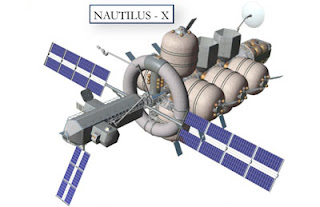Two Game Changing Technologies
The Gravity Loading Countermeasure Skinsuit (yes, that's Richard Garriott) and Mini-Magnetosphere Radiation Shielding are two technologies which, if successful, will change the way you think about space exploration and eventually even colonization. They address the two fundamental stumbling blocks of long term missions in space: the negative health affects of zero-g and radiation exposure.
Zero-G Skinsuits exert a force on the wearer's body which duplicates the loading on the skeleton that gravity usually provides. The expectation is that Skinsuits will reduce or eliminate the deleterious bone loss that astronauts currently experience in zero-g. So far, the prototypes have only been tested on parabolic flights, although they are similar to the Russian penguin suits which were used by cosmonauts on MIR (unfortunately with little to no reported results - as is typical of Russian space medicine).
Should Skinsuits turn out to be effective at eliminating bone loss, and possibly even have some positive effect on muscle loss, this finding will render other technologies aimed at addressing the problem less important. Specifically, solutions aimed at getting astronauts to Mars as quickly as possible will be less important. Artificial gravity generation for long trips or even for space colony designs will be less important too. Although there may still be a use for weak fluid settling variations on the theme, not having to produce an Earth-like gravity field is a much easier engineering problem.
MiniMags produce an electric field around a spacecraft that interacts with the interplanetary plasma to produce a charge separation, strengthening the field. When ionizing radiation hits the electric field it is deflected and so does not cause damage to the spacecraft or its occupants. It was widely believed that such a "magnetic shield" of solar radiation could not be achieved without superconducting magnets and large power sources - placing it firmly in the domain of science fiction. However, a number of observations of solar wind phenomena and subsequent ground experimentation has shown that only a small electric field is initially needed - the neutral interplanetary plasma will do the rest.
Should MiniMags turn out to be effective at protecting spacecraft and human occupants from ionizing radiation they will solve perhaps the biggest problem with long term human exploration of space, and eventual colonization. Previously, the only known way to deal with the radiation problem was to surround the crew with mass. Over the years, a number of creative techniques have been devised to have the mass serve double duty - for example, using propellant or consumables mass to shield the crew. Careful study of the available materials for shielding has led us to determine that high hydrogen content materials like polyethylene are best, suggesting that the interior of crew cabins should be lined in the stuff, and windows should be replaced with periscopes (because ionizing radiation only travels in straight lines and is not reflected by mirrors). All these design problems go away with an effective radiation shield.
At the time of writing, neither of these technologies is being adequately funded. While the NASA Technology Roadmaps currently identify "pressure garment" suits as a potential avenue for research, they place it in the EVA-suit category and seem to be unaware of Skinsuits. MiniMags are not identified in the technology roadmaps at all.. This is particularly egregious as not only can MiniMags be used as a radiation shield, but they can also be used for in-space propulsion. As such, they should appear in both TA06 and TA02. But never fear! I've informed the Aeronautics And Space Engineering Board of this oversight and I'm sure they'll get right on it ;)



Neat. The future for the skinsuits seems obvious: rent some room on a Bigelow habitat for a couple years and collect some medium-term data. By the time Mars mission designs will be seriously considered again, skinsuits will either be a proven technology or in the dustbin.
ReplyDeleteI'd like to say the same for MiniMags, but I don't know what they'd need for medium-term testing. Would a secondary GLXP payload in lunar orbit be enough?
Chris, probably yes. They're being done by a UK team of a academics who are currently looking to put a test unit on a GEO satellite. This has longevity benefits.
ReplyDeleteG'day,
ReplyDeleteWhat really needs to be done is to give zero G adaptions attempts a miss and learn how to spin the damn spacecraft. Decades of experience have proved that living in microgravity is a miserable experience.
Ralph, while I don't disagree, it's interesting to think about what it would mean to live in zero-g or very reduced gravity without the health effects.. from a long term colonization perspective it's not very satisfying - I doubt any suit will make gestation in zero-g work for humans - but it does mean you could slum it in zero-g to get to an asteroid which you can then use to build a large domicile with rotating artificial gravity.
ReplyDeletewindows should be replaced with periscopes
ReplyDeleteI think lots of little cameras are best, but depth of solution is even better (have as many different ways to do the same thing that if some fail others get the job done.)
Another great post.